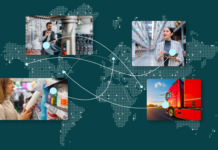The modern workplace is characterised by speed, agility, and efficiency. With all the technologies at enterprises’ disposal, there simply is no excuse why a task can’t be done faster, simpler, and smarter.
Panasonic Connect, which has a 13,400-strong workforce in Japan, recognises this fact, and has made it a mission to make its employees’ lives easier. The solution they have identified to transform the workplace and enhance efficiency is artificial intelligence.
Hiroki Mukaino, Senior Manager, IT & Digital Strategy, and Digital Marketing IT leader at Panasonic Connect, has identified key challenges within the company: time-consuming administrative tasks, employee productivity, and demographic barriers. To Mukaino, these issues are too big to be ignored.
“By integrating AI technologies into everyday processes, Panasonic Connect sought to streamline operations, increase efficiency, and enable employees to concentrate on tasks that utilise their unique skills and insights,” he said.
Solving the equation
Panasonic Connect envisioned an AI assistant that could help employees draft emails, gather information, and write code. The goal was to alleviate the labour-intensive and time-consuming aspects of office work, enabling employees to foster creativity and develop strategies to overcome business challenges.
Moreover, since a significant portion of Japan’s population is 65 years old and above, the company recognised the potential of AI to boost employee productivity. This technological integration aimed to free up employees’ time, allowing them to concentrate on tasks that require human expertise and innovation.
To achieve this goal, Panasonic Connect partnered with Microsoft, banking on the capabilities of the Azure OpenAI Service.

“This decision to partner with Microsoft and use the Azure OpenAI Service was driven by the need to prioritise data security. By choosing this trusted platform, Panasonic Connect sought to ensure the protection and privacy of sensitive company information,” Mukaino revealed.
The AI assistant, dubbed ConnectAI, was based on the GPT3.5-turbo model, sharing a similar foundation with ChatGPT, noted Kentaro Oda, Go-to-Market Manager (Data and AI), Microsoft Japan.
“Leveraging the power of OpenAI’s technology, ConnectAI offers comparable performance and capabilities to existing generative AI models like ChatGPT and Bard. Panasonic Connect had already been playing with the original OpenAI API version, so it wasn’t such a big hurdle for them. Since they wanted to make it available to all their employees and Azure OpenAI Service met their security needs, they decided to use it,” he said.
The integration of AI technologies with Panasonic Connect, Oda explained, involved a technically straightforward construction with minimal configuration, including the application layer. However, there were unique challenges and considerations specific to the language differences between English and Japanese.
“To address this, Japanese prompts were translated into English on the application logic side for input, and the generated answers from the language model were translated back into Japanese for user return,” Oda continued. “Microsoft collaborated with Panasonic Connect to overcome these challenges by implementing this translation process and ensuring accurate communication between the model and users.”
Nuts and bolts
ConnectAI can be accessed through a URL, which then provides a user-friendly interface for interacting with the AI assistant.
According to Mukaino, training procedures were kept minimal to avoid overcomplicating the usage of ConnectAI.
“Employees were guided on how to use the AI assistant effectively, including writing queries in the form of full questions instead of search terms. Additionally, sample questions were provided to employees as a reference, helping them understand how to formulate queries and interact with ConnectAI,” he said.
Meanwhile, the company emphasised the value of using the AI assistant in everyday tasks, to facilitate user acceptance and engagement.
“By positioning ConnectAI as a tool to alleviate labour-intensive work and free up time for more valuable activities, employees were likely motivated to explore and adopt the AI assistant,” Mukaino added.
Barriers removed
Almost immediately, Panasonic Connect observed positive responses from its employees with regards to the use of ConnectAI.
While Mukaino admitted that is still too early to fully evaluate the results of their AI deployment, there were already demonstrated use cases in various departments of the company.

An employee in the legal division, for instance, said ConnectAI significantly reduced the time spent reading long legal documents. Instead of dedicating an hour to reading a document, the employee now spends less than 10 minutes reviewing a summary generated by ConnectAI. This demonstrated time savings and increased efficiency in handling lengthy documents.
In the IT and digital department, another employee reported expedited analysis of free text results from employee IT surveys. Previously, the employee’s team of three would spend a week or more analysing the data manually, but with ConnectAI, they can obtain the analysis within an hour. This streamlined process saved significant time and enabled faster insights into IT issues.
“Despite the large number of daily queries logged, the IT team received zero calls for help on how to use the AI assistant. Employees were able to experiment with ConnectAI on their own and even organised brainstorming sessions within departments. This indicates that ConnectAI is user-friendly and doesn’t require extensive IT capabilities to navigate effectively,” Mukaino said.
Trailblazer
Panasonic Connect was among the first Japanese companies to sign up during the private preview stage of ChatGPT on Azure OpenAI Service, affording it the opportunity to test and explore the technology extensively.
It wasn’t long before Panasonic Connect reached the proof-of-concept testing stage, which resulted in a faster deployment time.
“This swift progress, although technically simple, generated significant attention in Japan as one of the fastest examples of its kind. The collaboration with Panasonic Connect served as a pioneering best practice, attracting various users who were interested in replicating the success or seeking assistance in implementing similar AI applications,” remarked Microsoft’s Oda.
Down the line, Panasonic Connect wants to use ConnectAI to create a more personalised experience for its customers.
“For example, customer service representatives may be able to utilise ConnectAI to quickly provide answers to customer queries regarding product specifications. This indicates a focus on improving customer service and engagement through AI-powered solutions,” Mukaino concluded.
















